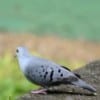 By Jim Stevenson
By Jim Stevenson
Sorry for a subpar picture, but even a glimpse of the Blue Ground-dove is a real pleasure. They are lowland birds, scattered (as far as I can tell) mostly in NE and SW Costa Rica, being quite regular in Golfito. They are also not tame, perhaps conditioned by bird guides yelling and pointing at them (?), and I’ve never been able to get a satisfying shot of one.
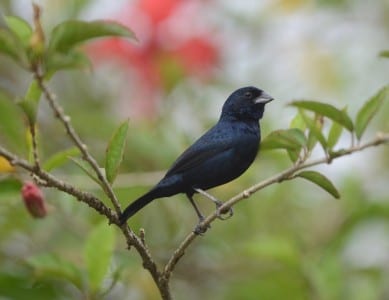
The tiny Blue-black Grassquit ranges over much of Central America and northern South America. They are tame and abiding, often seen on barbed wire fences along roadsides. The females join a dizzying group of brown finches, encouraging us birders to look for their males. These have smaller bills than seed eaters, and are shinier.
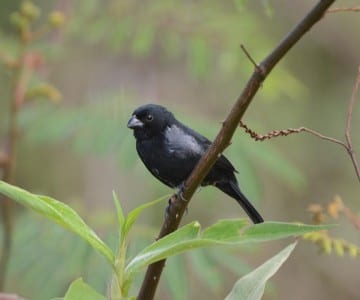
This is an odd male Variable Seedeater, but as the name implies, they can look a lot of different ways. There is a feather or two displaced on the breast, giving him an odd look. They also have a tiny flash of white on the wing, reminiscent of our Orange-crowned Warblers of winter (well, sorta), but it serves to separate them from Grassquits.
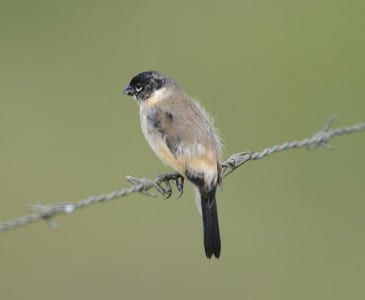
Seedeaters, like many species, can be additionally variable as their plumage changes, as this young male is showing us. The area around Zapata, Texas, has the White-collared Seedeater, but that’s it for this tropical group. Some finches have fairly long hind toes (hallux), not quite as long as some other open-land birds like meadowlarks, etc.
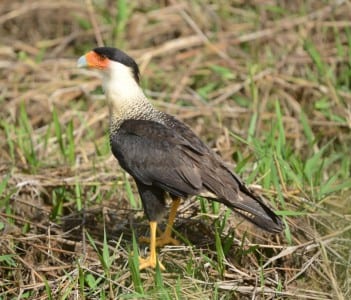
Crested Caracaras are simply all over Central and South America lowlands, learning to trust people who seldom have guns. They are largely scavengers down here, joining vultures on road kills. Curiously, they enjoy dust baths, which they take communally in groups of 5-10. This individual has an especially bright cere.
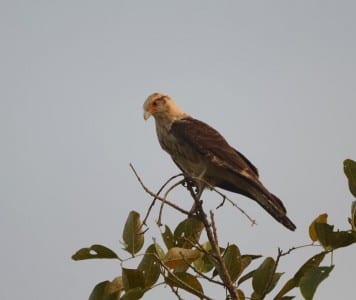
The smaller Yellow-headed Caracara hasn’t made it to the US but ranges widely over Tropical America. I think they hunt a little more and have learned to work coastlines for food – a trait our Galveston (Crested) Caracaras are just now learning to do. Caracaras used to be in the falcon family – a silly designation – but that’s all changed now.
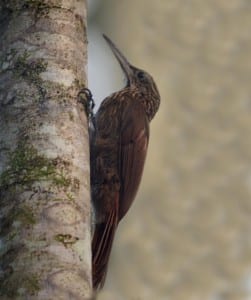
These Woodcreepers present a dizzying array of similar species, and with flycatchers and some other groups, the Tropics presents a far harder atmosphere for birding. Note the bill is straight and the bird is dark and streaked up front. Also notice the toes are not arranged like woodpeckers, as they are very far apart.
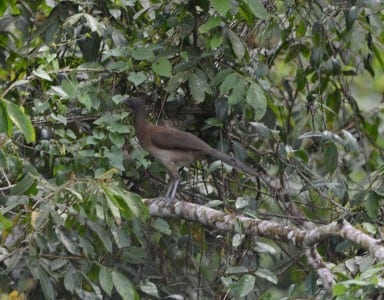
Chachalacas are found from the Rio Grande Valley (Plain Chachalaca) to the middle of South America. This is the Gray-headed, a bird of moist, low forests. These relatives of quail stay in small flocks, working their way through the canopy, eating leaves and berries. Not sure if they eat insects, but it’s a great source of protein.
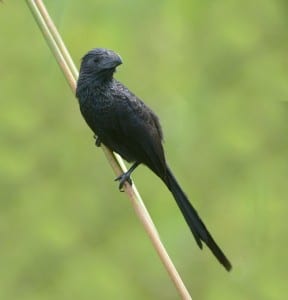
Groove-billed Anis are common in the drier regions of the Tropics, reaching their northern limit (regularly) in South Texas. Their close relative the Smooth-billed Ani, which has no grooves (you knew that) lives in the more moist areas of SW CR. They were in Florida but I’m not sure they still exist there. Groovies are still in South Texas. This Great-tailed Grackle is, … What did you say?
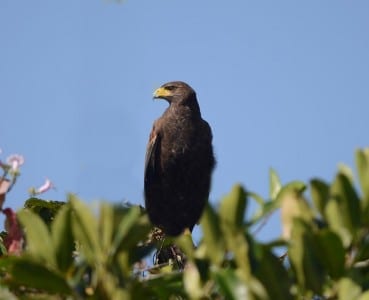
This Harris’s Hawk is curiously sitting along the edge of the waterway, not in the dry areas where it belongs. Go figure. Some field guides call them Bay-winged Hawks but I *think* it’s the same species. In the Desert Southwest, they nest in family groups, with (usually) one pair reproducing.
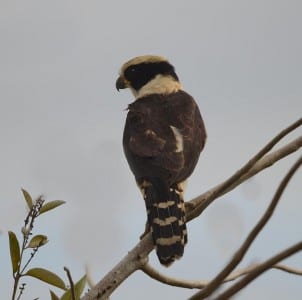
Laughing Falcons are lowland hunters, often heard yelling back and forth between mates. Predators with dark masks are hiding their eyes, as they scare potential prey, and their prey can often get away without a little subterfuge. Like other falcons, they have quite a wicked hook on the bill, useful for snapping necks.
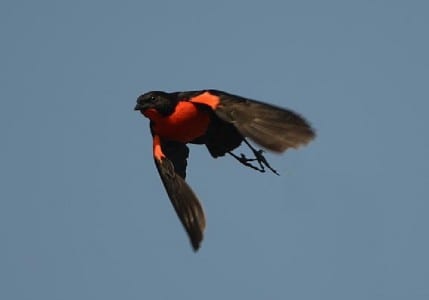
Red-breasted Blackbirds are one of the neat species that’s made it to Costa Rica, and is heading northward all the time. I have only seen males in CR but that is likely on account of the disparity in color. Like most non migratory songbirds, they have rather rounded wings, “choosing” to maneuver more than accrue speed.

These Tropical Kingbirds do get around! They are residents from just inside the US in Texas and Arizona to well down South America. They don’t have the white outer tail feathers of our Western, but are very similar to the Couch’s of South Texas. Those two are not safely separated except by call, where both are found.
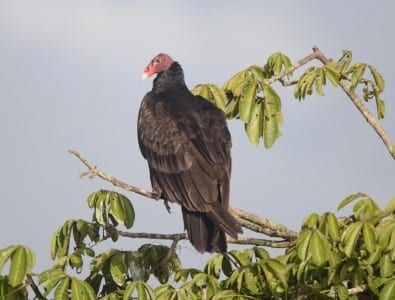
Please remember this Turkey Vulture’s bare head. When I send you pictures from South America, you’ll see a white patch on the back of the head that denotes the SA subspecies. Check out the size of the nostrils, helping them use their olfactory senses to locate rotting flesh. Isn’t that an interesting beak?
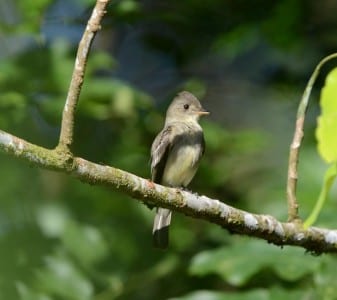
This is a rather humorous Western Wood-pewee, as a shadow from the limb is creating the same breast band often seen (less markedly) in many of this species. There are several pewees – small flycatchers in the Western World- and they can be a booger bear to figure out. I have found several Westerns in my yard, all of which were accepted by the TBRC, and the grayness of them was the first thing I noticed.
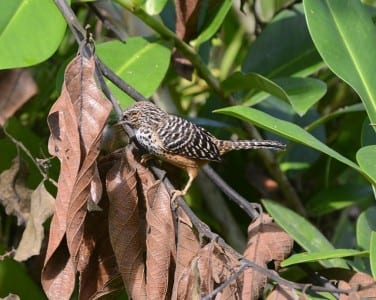
Band-backed Wrens are very large, noisy wrens usually seen in family groups. Like all wrens, they rely on their colors and pattern to helpthem remain inconspicuous, and will issue their loud songs from the cover of leaves. Most wrens have over sized beaks for probing into vegetation for insects and spiders.
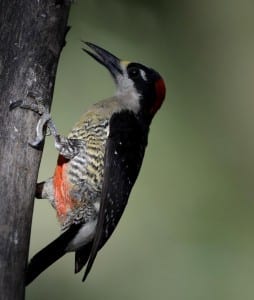
Black-cheeked Wdpkrs are one of the Melanerpes (like our red-bellied) that doesn’t look like the others. It does have the red on the belly seen in others often, and this shot is a good study ofthe woodpecker family’s adaptations in general. You can see the wide grasp of the zygodactyl toes, the long, stiff tail feathers for propping itself up, the chisel beak and the long tongue for snatching out bugs from their hiding places.
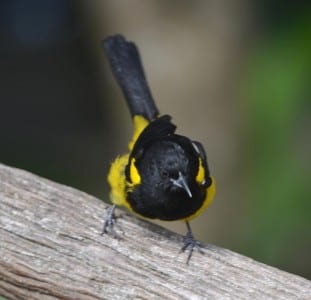
The Black-cowled Oriole is one of the “yellow-and-black” species of that family found in Tropical America. Other species have more orange, such as in North America. It is rather curious that sexual dimorphism is the rule in North American orioles but generally not in tropical species. Hopefully, they get it figured out by breeding season.
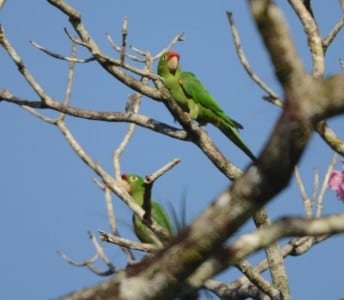
The order Psittaciformes is a huge one, made up largely of tropical species and groups. The macaws are the largest, and these parakeets resemble macaws with that long, tapered tail, but are much smaller. Parrots are chunky but have short tails, as most of you know. Parrotlets are tiny parrots, and then there are the Australian birds!

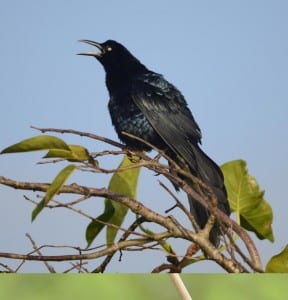
 Posted in
Posted in 
























They may also decide to garnish your paycheck, greatly
reducing just how much of take home income you might have Unknown this is to be performed using a
number of sequential steps.